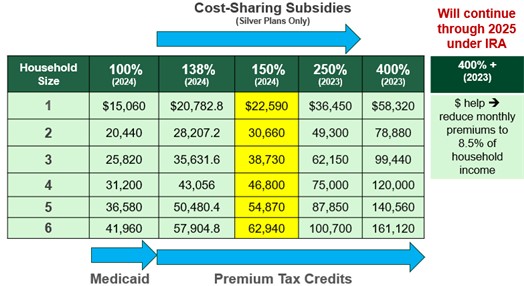Expanded Medicaid:
These states have expanded access to Medicaid under the ACA, providing coverage for people with household incomes up to 138% of the federal poverty level: AK, AR, AZ, CA, CO, CT, DC, DE, HI, IA, ID, IL, IN, KY, LA, MA, MD, ME, MI, MN, MO, MT, NC, ND, NE, NH, NJ, NM, NV, NY, OH, OK, OR, PA, RI, SD, UT, VA, VT, WA, WV.
If you live in a state with expanded Medicaid:
- Household income up to 138% of the federal poverty level (FPL): You have access to Medicaid.
- Household income between 138-250% FPL: You have access to premium tax credits and cost-sharing subsidies (if you pick a silver health insurance plan).
- Household income under 150% FPL: You are eligible for a Marketplace plan for less than $10 per month.
- Household income between 250-400% FPL: You have access to premium tax credits.
- Household income above 400% FPL: You can buy a Marketplace plan, but you will not qualify for financial assistance, unless your premiums cost you more than 8.5% of your household income. Note: this is a special rule only through 2025. Some states may provide additional assistance.

Note: the FPL numbers for the current year are used to determine Medicaid eligibility. The FPL numbers for the previous years are used to determine Marketplace financial assistance.
If you live in a state without expanded Medicaid (AL, FL, GA, KS, MS, SC, TN, TX, WI, WY):
- Household income between 100- 138% FPL: You have access to cost-sharing subsidies (silver plans only).
- Household income between 138- 250% FPL: You have access to premium tax credits and cost-sharing subsidies (if you pick a silver health insurance plan).
- Household income between 250-400% FPL: You have access to premium tax credits.
- Household income above 400% FPL: You can buy a Marketplace plan, but will not qualify for financial assistance, unless your premiums cost you more than 8.5% of your household income. Note: this is a special rule only through 2025.
Also new:
There is a new, monthly special enrollment period (SEP) for consumers with a household income under 150% of the FPL, to enroll in a Marketplace plan anytime during the year. Consumers can also switch to a silver plan if they have another plan level, and they can switch silver plans anytime during the year. States that run their own Marketplaces can choose to offer this SEP or not.




